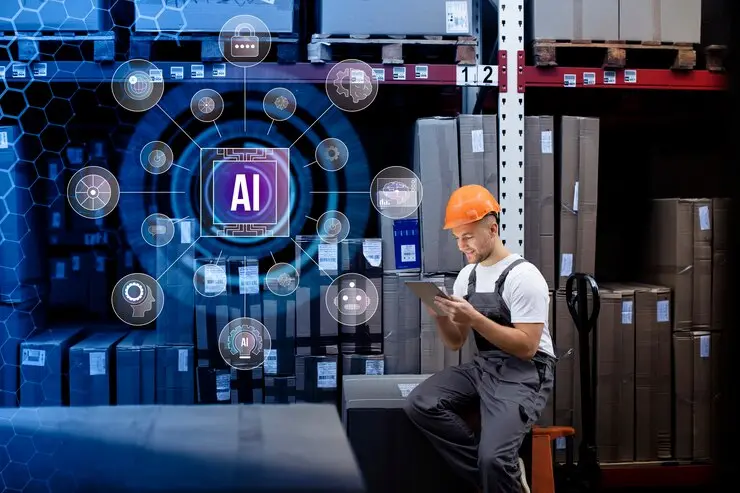Introduction: The Dawn of a New Era in Creativity
Welcome to the exciting world of Artificial Intelligence (AI) in creative industries! In this era of technological marvels, AI isn’t just a tool; it’s a collaborator that’s reshaping how we approach creativity. From music production to literature, and from film making to visual arts, AI is making its mark. In this comprehensive guide, we’ll explore the myriad ways AI is influencing the creative sectors, bringing new perspectives, challenges, and opportunities.
Section 1: AI in Music – Composing the Future Paragraph 1
Imagine a world where music is not just created by humans, but also by intelligent machines. AI in music is revolutionizing the way tunes are composed, produced, and distributed. Using algorithms that can analyze patterns in music, AI systems are now able to create original compositions in various genres, offering a fresh sound palette to artists and producers.
Paragraph 2
This isn’t just about robot composers, though. AI tools are aiding musicians in enhancing their creativity, offering new avenues for experimentation. From generating unique beats to suggesting chord progressions, AI is becoming an indispensable asset in the modern musician’s toolkit.
Section 2: AI-Powered Literature – Writing the Unwritten Paragraph 1
In the realm of literature, AI is transforming the role of the author. AI algorithms can now assist in drafting narratives, suggesting plot twists, or even generating entire short stories. This collaboration between human creativity and machine intelligence is opening up new possibilities in storytelling.
Paragraph 2
But it’s not just about creating new works. AI is also helping in analyzing literature, offering insights into themes, styles, and narrative structures. This not only aids in academic research but also helps writers understand and innovate within their craft.
Section 3: Visual Arts and AI – A Canvas of Possibilities Paragraph 1
The impact of AI in visual arts is nothing short of revolutionary. AI algorithms are being used to create stunning visual imagery, challenging the traditional boundaries of art. From generating abstract compositions to recreating historical art styles, AI is proving to be a versatile artist.
Paragraph 2
Moreover, AI in art extends beyond creation. It’s also being used for restoration of old artworks, helping in understanding and preserving our cultural heritage. AI’s ability to analyze and recreate textures and colors is a boon for art conservationists.
Section 4: AI in Filmmaking – Directing the Digital Age Paragraph 1
Filmmaking is another creative frontier where AI is making a significant impact. From scriptwriting to post-production, AI tools are streamlining the filmmaking process. AI algorithms can suggest plot enhancements, edit sequences, and even predict audience reactions.
Paragraph 2
Furthermore, AI is revolutionizing special effects, enabling creators to bring to life the most intricate and fantastical ideas. The integration of AI in filmmaking is not just about efficiency; it’s about expanding the horizons of cinematic storytelling.
Section 5: AI in Animation and Graphic Design Paragraph 1
The field of animation and graphic design is being transformed by AI’s capabilities. AI tools can automate tedious aspects of animation, such as lip-syncing and character movements, allowing animators to focus more on creative aspects.
Paragraph 2
In graphic design, AI algorithms assist in generating layouts, color schemes, and even logos, offering a starting point for designers to refine and personalize. This synergy of AI and human creativity is bringing about a new age of digital design.
Section 6: AI and the Future of Creativity – Ethical Considerations Paragraph 1
As AI becomes more ingrained in creative processes, it raises important ethical questions. Issues like originality, copyright, and the role of AI in artistic expression are at the forefront of discussions. It’s essential to navigate these challenges thoughtfully to ensure that AI serves as a tool for enhancement, not replacement, of human creativity.
Paragraph 2
Moreover, there’s the issue of accessibility and bias. Ensuring that AI tools in creative industries are accessible to all and free from biases is crucial for fostering a diverse and inclusive artistic community.
Section 7: AI in Advertising and Marketing – Crafting Persuasive Narratives Paragraph 1
In advertising and marketing, AI is being employed to create more engaging and personalized content. AI algorithms can analyze consumer behavior and preferences, enabling brands to tailor their messaging more effectively.
Paragraph 2
AI is also aiding in content generation for marketing campaigns, from writing copy to creating visuals. This leads to more dynamic and resonant marketing strategies that can better connect with target audiences.
Section 8: AI in Fashion – Designing the Future Paragraph 1
The fashion industry isn’t far behind in embracing AI. From predicting trends to designing outfits, AI is playing a growing role in fashion. It’s helping designers understand and anticipate consumer preferences, leading to more personalized and sustainable fashion.
Paragraph 2
AI is also revolutionizing the supply chain in fashion, optimizing everything from inventory management to customer experience. This integration of AI in fashion is not just about aesthetics; it’s about creating a smarter and more responsive industry.
Section 9: AI in Gaming – Crafting Immersive Experiences Paragraph 1
In the gaming world, AI is a game-changer, quite literally. AI is used to create more realistic and responsive game environments, enhancing the player’s immersion. From non-player character (NPC) behavior to dynamic storytelling, AI is elevating the gaming experience.
Paragraph 2
Furthermore, AI is aiding in game development, from level design to testing. This allows for more complex and engaging games, pushing the boundaries of what’s possible in virtual worlds.
Conclusion: Embracing AI in Creative Industries
As we’ve explored, AI’s role in the creative industries is multifaceted and ever-evolving. It’s a partnership that’s redefining the boundaries of creativity, offering new tools and perspectives. The future of AI in creativity is bright and brimming with potential. Let’s embrace this digital renaissance and see where this journey takes us!
Explore the rest of our website Tech Glints, intriguing articles await you! Interested in contributing? Simply click the contact button at the top right. Thank you!
